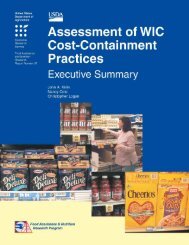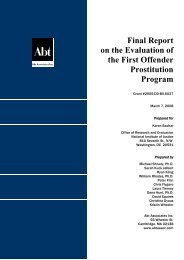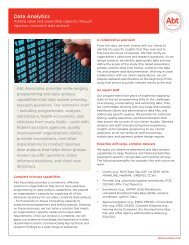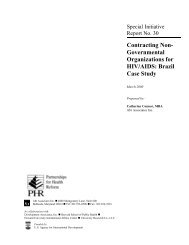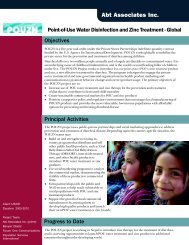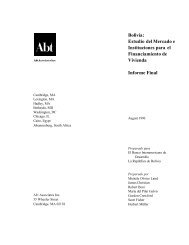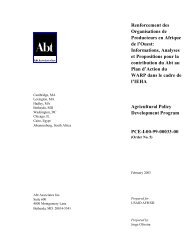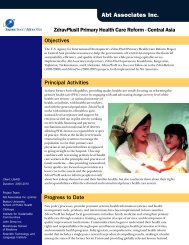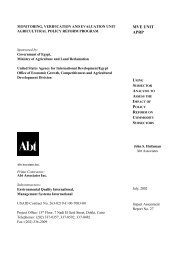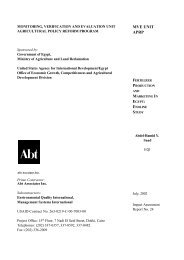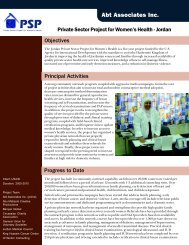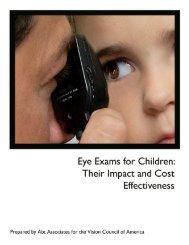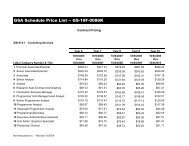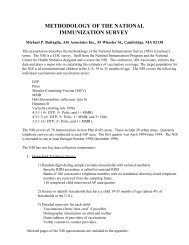Investment Project #5, High-Value Agriculture and ... - Abt Associates
Investment Project #5, High-Value Agriculture and ... - Abt Associates
Investment Project #5, High-Value Agriculture and ... - Abt Associates
Create successful ePaper yourself
Turn your PDF publications into a flip-book with our unique Google optimized e-Paper software.
Comprehensive<br />
Development Plan for the<br />
City of Luxor, Egypt –<br />
<strong>Investment</strong> <strong>Project</strong> <strong>#5</strong>,<br />
<strong>High</strong>-<strong>Value</strong> <strong>Agriculture</strong><br />
<strong>and</strong> Agroprocessing<br />
Industries in Luxor City<br />
Cambridge, MA<br />
Lexington, MA<br />
Hadley, MA<br />
Bethesda, MD<br />
Washington, DC<br />
Chicago, IL<br />
Cairo, Egypt<br />
Johannesburg, South Africa<br />
Executive Summary<br />
January 2000<br />
Prepared for<br />
The Ministry of Housing, Utilities<br />
<strong>and</strong> Urban Communities //<br />
Research <strong>and</strong> Studies<br />
Organization, Egypt<br />
<strong>Abt</strong> <strong>Associates</strong> Inc.<br />
55 Wheeler Street<br />
Cambridge, MA 02138<br />
Prepared by<br />
Gabriel Abraham<br />
Alan Edmond<br />
Ashraf Bakr
The Development of <strong>High</strong>-<strong>Value</strong> agriculture in Luxor City, Egypt<br />
<strong>Investment</strong> <strong>Project</strong> <strong>#5</strong><br />
Establishment of <strong>High</strong>-value <strong>Agriculture</strong> <strong>and</strong> Agroprocessing Industrie s in Luxor<br />
2.0 Executive Summary<br />
The Comprehensive Development for the City of Luxor (CDCL) is a long range plan that the Government<br />
of Egypt (GOE) <strong>and</strong> the <strong>High</strong>er Council for the City of Luxor (HCLC) consider a key to the orderly<br />
growth of the city, the region, <strong>and</strong> the Upper Egypt tourism industry, all of which face a great expansion<br />
over the next two decades. Recent experience in the Red Sea area points to the potential for tremendous<br />
benefits to those local <strong>and</strong> regional economies which are assisted by comprehensive physical plans.<br />
Central to the CDCL is the need for economic growth which includes local residents in the economic<br />
sectors, <strong>and</strong> which will serve the needs of a greatly exp<strong>and</strong>ed tourism industry <strong>and</strong> the naturally growing<br />
local population. As one of the six investment projects developed as central themes for the CDCL by<br />
working groups (WG) <strong>and</strong> the MHUUC, high-value agriculture is seen as one of the economic<br />
opportunities that Luxor is poised to enjoy.<br />
This investment project is a st<strong>and</strong>-alone document which provides a description of the <strong>High</strong>-value<br />
<strong>Agriculture</strong> <strong>and</strong> Agroprocessing Industries prospects for the Luxor region, <strong>and</strong> as a component of the<br />
overall CDCL. It outlines the importance of <strong>High</strong>-value <strong>Agriculture</strong> <strong>and</strong> Agroprocessing Industries, the<br />
prerequisites that go into making it successful, <strong>and</strong> the prospects for Luxor to participate in a vibrant highvalue<br />
agriculture industry. <strong>High</strong>-value <strong>Agriculture</strong> <strong>and</strong> Agroprocessing Industries can therefore help meet<br />
the contemporary needs of the local residents, a prerequisite for the overall CDCL to be successful.<br />
This document also serves as a component of the Structure Plan for Luxor that may be used as<br />
background <strong>and</strong> reference material for investors, government officials, <strong>and</strong> anyone interested in the<br />
potential for high-value horticulture in Luxor’s future. It is a guide for further actions which will help<br />
realize the CDCL’s goals.<br />
Among the leading agricultural countries of the region, Egypt is uniquely situated to produce <strong>and</strong> market<br />
high quality horticultural products from both existing <strong>and</strong> reclaimed l<strong>and</strong>. L<strong>and</strong> reclamation projects are<br />
widespread in Egypt, <strong>and</strong> are based on well-known techniques, particularly in the areas of irrigation,<br />
fertilizers, <strong>and</strong> crop management.<br />
The Nile Valley in the Luxor region can support the production of vegetables <strong>and</strong> fruits which will supply<br />
the growing tourist facilities in the area as well as the growing local population. It is also possible that<br />
eventually the region will be able to supply the Middle East <strong>and</strong> Europe with certain of those products.<br />
Small-scale agriculture is well established in the area. Through l<strong>and</strong> reclamation <strong>and</strong> efforts to improve<br />
crop choice <strong>and</strong> management, as well as post harvest processes, small-scale agriculture can be much more<br />
profitable for local growers. <strong>High</strong> quality fruits <strong>and</strong> vegetables which are locally grown will reach hotel<br />
tables in significant volumes.<br />
A major goal, then, is to maximize the effectiveness of local farming efforts through crop management<br />
<strong>and</strong> marketing improvements. A second goal is the protection of open spaces by providing farming uses<br />
of the l<strong>and</strong> which are complementary to the development of the East Bank in particular for tourism <strong>and</strong><br />
new residential <strong>and</strong> commercial development.<br />
The agricultural sector in Egypt is continuing to become decentralized <strong>and</strong> to enjoy a loosening of<br />
restrictions on l<strong>and</strong> use, pricing, <strong>and</strong> export controls. A number of government institutions serve the<br />
agricultural sector, yet the trend is toward privatization of cultivation, processing, marketing, <strong>and</strong><br />
9
The Development of <strong>High</strong>-<strong>Value</strong> agriculture in Luxor City, Egypt<br />
shipping of products. Reclamation of l<strong>and</strong> continues on a large scale, with auctioning of l<strong>and</strong> <strong>and</strong><br />
farmsteading programs leading to private sector tenancy <strong>and</strong> ownership of both large tracts <strong>and</strong> small<br />
parcels.<br />
The reclamation projects have produced a solid body of lessons learned. Horizontal growth of the<br />
farming sector has been aided greatly by having the private sector manage production <strong>and</strong> distribution,<br />
while the public sector provides arable l<strong>and</strong> <strong>and</strong> technical assistance. The government enables expansion<br />
<strong>and</strong> provides basic infrastructure facilities, <strong>and</strong> the private sector builds the secondary infrastructure <strong>and</strong><br />
other facilities needed for farm families <strong>and</strong> agribusinesses.<br />
This project is highly consistent with the GOE’s overall plans for agricultural expansion <strong>and</strong> the Upper<br />
Egypt 2017 Plan. Horticulture is a priority for the GOE, which has a policy of limiting sugar cane<br />
production in favor of high-value, low water consuming crops on new l<strong>and</strong>s. Various farmsteading<br />
programs have stressed the need for high-value crops, <strong>and</strong> in some cases water has been allocated for new<br />
l<strong>and</strong>s based on the ability of the region to save water by using modern subsurface drip irrigation, <strong>and</strong> by<br />
moving away from sugar cane production or making such production less dem<strong>and</strong>ing on water supplies.<br />
The project envisioned for Luxor is based on several factors which hold great promise. Luxor has several<br />
highly favorable characteristics for horticultural production. Among those are its excellent transportation<br />
systems, its access to Nile water, its large agricultural labor pool, its existing <strong>and</strong> projected tourist<br />
population that are based on solid archaeological attractions, <strong>and</strong> the climate that provides for three to<br />
four crops per year.<br />
Luxor is attractive as an area for agricultural investment, in conjunction with other industries which<br />
support tourism in general. The GOE has announced the reclamation of up to 18,000 feddans in the area,<br />
as well as the massive New Valley reclamation project to the South.<br />
As with other projects in the CDCL, the Luxor high-value agricultural project will be managed through a<br />
cooperative arrangement among government agencies <strong>and</strong> the private sector. The Ministry of <strong>Agriculture</strong><br />
<strong>and</strong> L<strong>and</strong> Reclamation (MALR) will be the overall ministry implementing body, working in close<br />
collaboration with the HCLC. Based on the st<strong>and</strong>ard CDCL model, a <strong>Project</strong> Implementation Unit will<br />
be established, comprised of experts from an array of skill areas having to do with regional development.<br />
Agricultural specialists from the public <strong>and</strong> private sectors will be involved at all stages of technical<br />
assistance.<br />
The project will determine the most advantageous ways in which small plots might be managed for the<br />
highest yields <strong>and</strong> best marketing possibilities. This might include the optimization of grower<br />
associations.<br />
The project will assist the HCLC in developing its capacity to manage some of the l<strong>and</strong> use control issues<br />
necessary for this effort to be a successful part of the CDCL. This will include staff assistance <strong>and</strong><br />
training in certain social planning areas as well as the technical aspects of l<strong>and</strong> use control <strong>and</strong> long range<br />
planning. The project will also contribute to the upgrading of the local agricultural school curriculum <strong>and</strong><br />
the outreach (extension) services to be provided by the MALR <strong>and</strong> private agencies.<br />
Target groups to benefit from the project are recent graduates, l<strong>and</strong>less residents, <strong>and</strong> investors in the<br />
larger parcels. Secondary beneficiaries will be those involved in storage <strong>and</strong> shipping, <strong>and</strong> retail markets<br />
for the horticultural products.<br />
Environmental consequences of the program will be overwhelmingly positive, resulting in much<br />
improved l<strong>and</strong> use practices, as well as all the benefits of green space. Care must be exercised in the<br />
10
The Development of <strong>High</strong>-<strong>Value</strong> agriculture in Luxor City, Egypt<br />
design of farm parcels, especially as to their potential for producing chemical <strong>and</strong> other harmful runoff<br />
onto adjoining l<strong>and</strong>s <strong>and</strong> into the canal system.<br />
There will be a low amount of risk to investors <strong>and</strong> farmsteaders, in that increased dem<strong>and</strong> for<br />
horticultural products is expected to remain strong <strong>and</strong> grow among the general population <strong>and</strong> the tourist<br />
groups.<br />
This project will require the marshaling of skills needed to maintain a competitive advantage for local<br />
farmers in the horticultural marketplace. There will need to be a concerted technical assistance effort to<br />
ensure the highest quality of management in the planting, growing, harvesting, <strong>and</strong> post harvest stages of<br />
production, as well as coordinated marketing effort in the local economy.<br />
11



